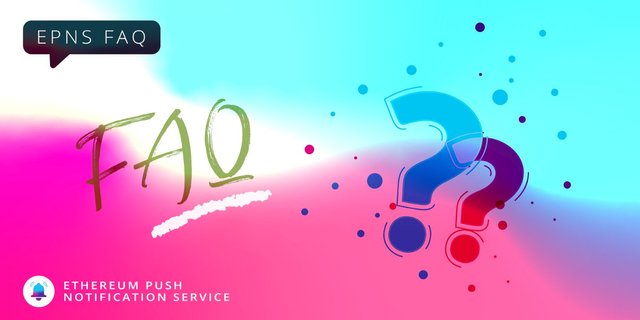Still wondering or having questions about what EPNS does?

Find answers to all your questions with the help of EPNS-FAQ.
It's very comprehensive and simplified.
Q. What does EPNS do?
Ethereum Push Notification Service (EPNS) is a platform-agnostic, decentralized notification protocol for Ethereum-based Web 3.0 applications. It enables users to receive notifications for on-chain or off-chain activity. EPNS allows Web3 actors (users, dapps, service providers) to create notifications that are triggered if and when a smart contract reaches certain conditions. Other Web3 participants can search, browse, and subscribe to specific notifications and more confidently interact with dapps. In doing so, EPNS combines the seamless user experience of Web 2.0 apps with the security and power of Web 3.0.
Q. What are some of the use cases for EPNS?
We believe almost any application in the Web3 ecosystem can benefit from notifications. Some of the highest-impact immediate opportunities are:
DEXes: DEX users can be notified when the price of a token falls or rises a certain percentage. Users can also set up notifications for when their trades are executed and completed, rather than having to check back to see if trades were completed (especially during times of high network traffic). Users can also set up notifications for when gas prices go down or up to help them decide when to trade.
DeFi: Lending protocol users can set up notifications to be informed when they are about to be liquidated, rather than needing to check in regularly to ensure. LP providers can also set up notifications about impermanent loss in case they wish to cut their losses short during a volatile market. If DeFi users are interacting with a particularly young or untested protocol, they could set up notifications to inform them if large amounts of funds are being moved around in ways that could signal instability within that dapp.
NFTs and Gaming: Trading of NFTs or goods on markets or within games can be connected to EPNS to inform users -
- when certain goods go on sale or auction;
- when auctions go live from crypto-artists;
- when a bid is accepted or topped;
- when one’s own NFT (or anyone else’s) sells.
- ENS/Consumer Apps: Apps like the Ethereum Name Service (ENS) and Crypto can notify users when their subscriptions are about to expire, rather than expecting users to remember or check in regularly to remind themselves of upcoming dates.
Q. Why should I use EPNS?
Because for so long, as a Web3.0 user, you waited on Twitter or Telegram for important updates and communications from your favorite dApps. Developers suffered while sending necessary information regarding their app or product over social media, hoping for their users to see it. Of course, without certainty. Consequently, users missed out on crucial notifications, alerts, notices, and offers. EPNS solves these, plus incentivizes both senders and receivers with usage rewards.
Q. What are the EPNS Products?
The EPNS product suite comprises the following elements:
EPNS Protocol: The main goal of the EPNS Protocol is to make sure all notifications are prepared and sent in compliance with the protocol standards. This will make every notification readily available to be picked up by the PUSH Nodes in charge of dispatching.
PUSH Nodes: The main goal of the PUSH Nodes is to listen to events in the EPNS protocol smart contracts and dispatch the notifications to the corresponding recipients.
Governance: Governance is crucial for any decentralized protocol, and EPNS is no exception. We already have introduced liquidity mining and staking along with ROCKSTAR of EPNS NFT and PUSH rewards.
Alpha dApp: Using the dApp, Subscribers can receive notifications from web browsers, while Channels can send notifications to decentralized carriers.
Mobile App: The mobile app serves the crucial purpose of sending notifications from decentralized protocols to centralized ecosystems, such as Android, iOS, and so on.
Showrunners: These are channels through which the EPNS Foundation sends notifications for the benefit of the community. Sending notifications about domain expiry, liquidation, and abnormal gas prices are some of the intended purposes of these channels.
Development SDKs and Documentation: For developers looking to easily integrate EPNS with partners, we’ll be releasing the following SDKs — Front-end SDK, Back-end SDK, PUSH Mobile SDK, EPNS Subgraph.
Read more: https://t.co/Whn7fi6l9X